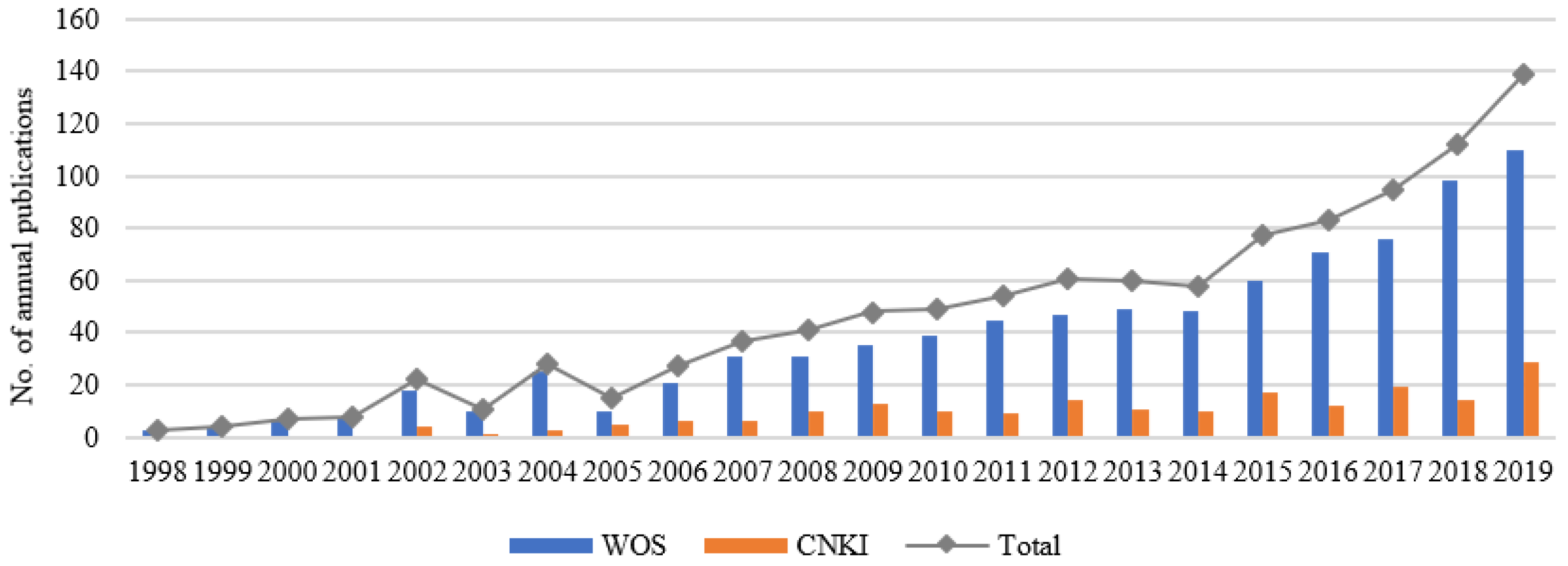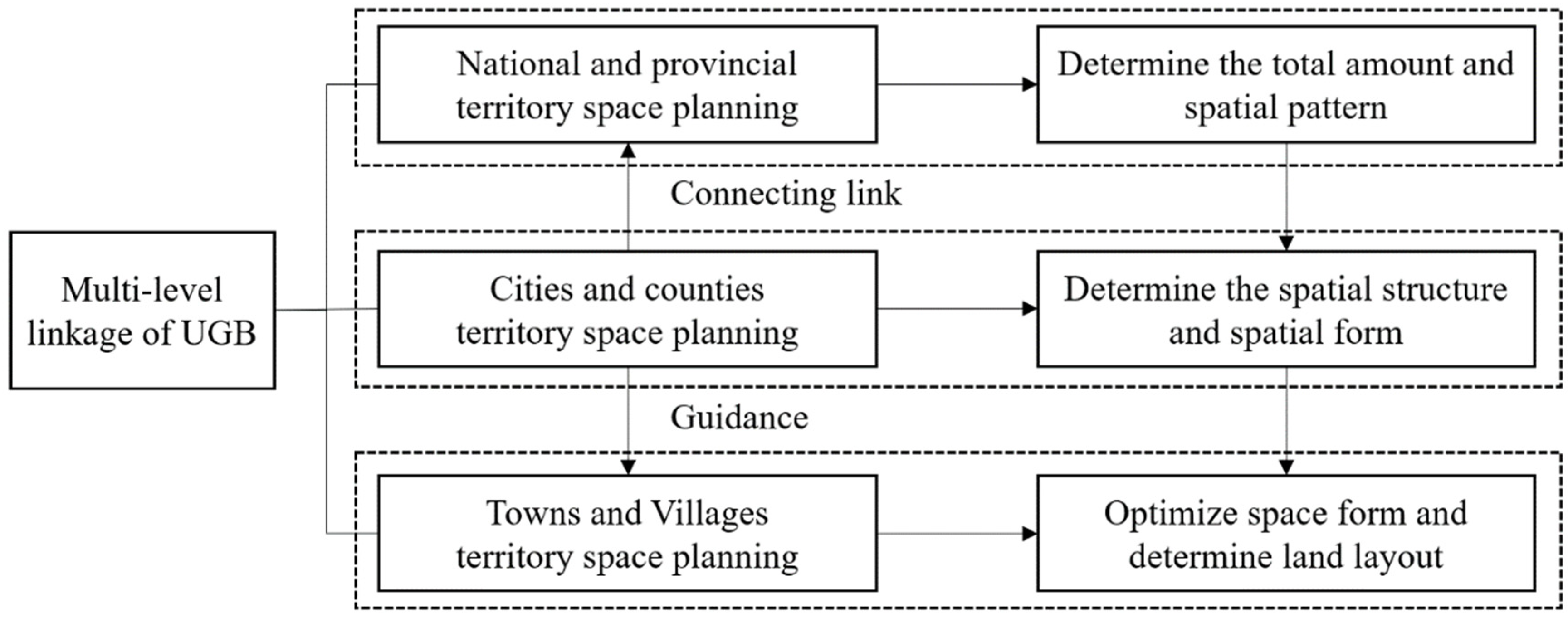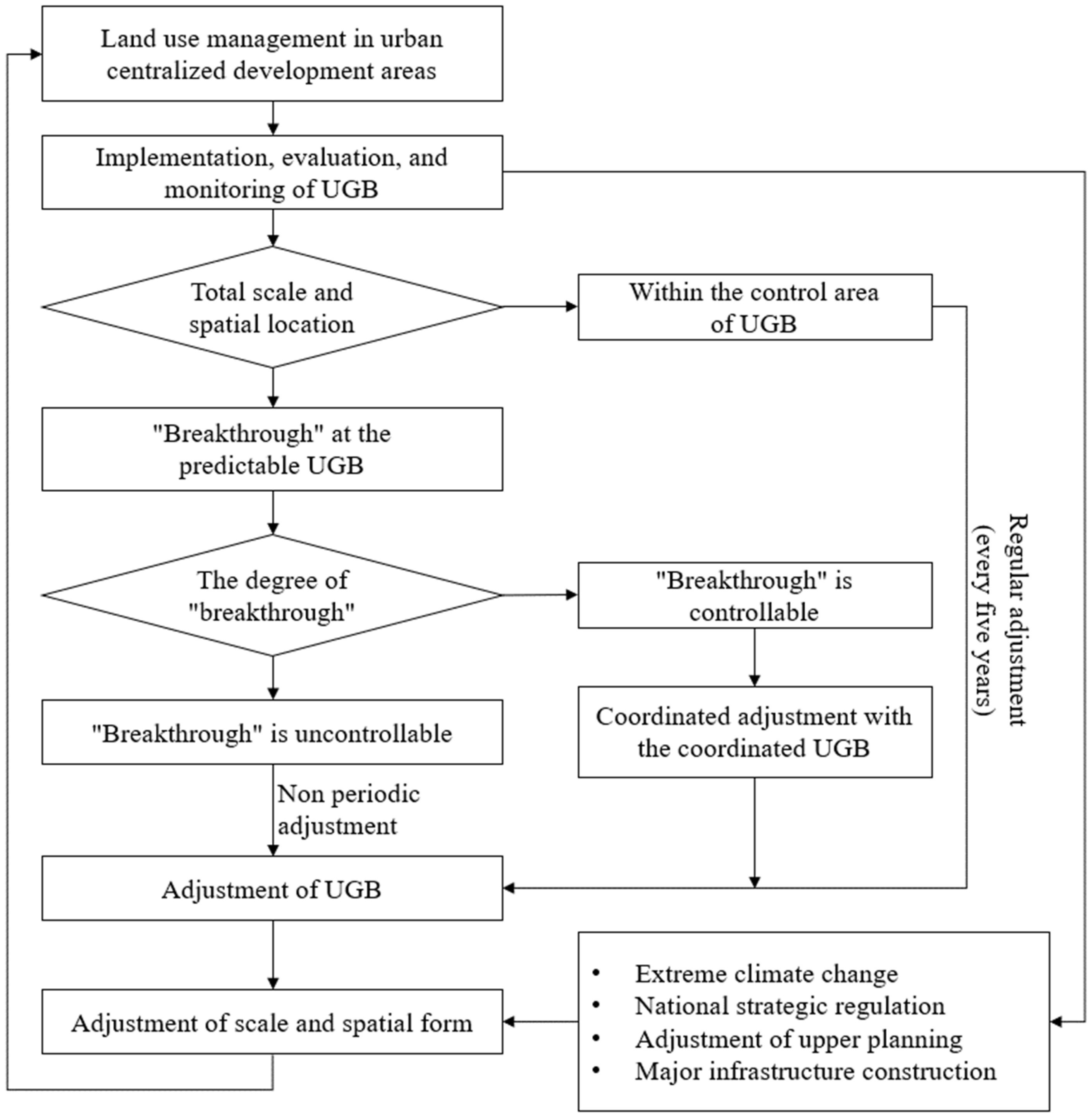Progress of Research on Urban Growth Boundary and Its Implications in Chinese Studies Based on Bibliometric Analysis
Abstract
:1. Introduction
2. Methodology
3. Results
3.1. Bibliometric Analysis of UGB
3.1.1. Research Hotspots of UGB
3.1.2. Research Frontiers of UGB
3.2. Literature Review of UGB
3.2.1. Development Process of UGB
3.2.2. Delineation Method of UGB
Qualitative Delineation Method
Quantitative Delineation Method
- (1)
- Forward expansion method based on urban development orientation
- (2)
- Reverse qualification method based on ecological conservation orientation
3.2.3. Supporting Policies of UGB
4. Discussion
4.1. General Review of the Study
- (1)
- The UGB theory is a policy tool proposed in the US to cope with urban sprawl. Early green belt planning was aimed at controlling the spatial spread of urban built-up areas, and with metropolitan development and population growth, its function gradually changed to reasonably guiding the orderly development of urban or regional spaces. The UGB theory was first proposed and practically implemented in Salem, USA in 1976, and then it was gradually adopted and emulated by other cities worldwide. Since its introduction into China, the UGB policy has become one of the three major policy tools of the territorial spatial planning system, with the aim of guiding rational land development and ecological resource protection around the city.
- (2)
- Theoretical research on UGBs can be divided into three main directions: first, the definition of the UGB concept, the evolution of its connotation, and the comparison between China and foreign countries; second, the technical routes and methods of boundary delineation; and third, the supporting management and implementation policies of the boundary control system. The technical methods of boundary delineation are the focus of research, with the “forward expansion” and “reverse restriction” methods oriented toward the needs of urban development and ecological protection, respectively; both methods have their own advantages and shortcomings. However, the boundaries drawn by the reverse restriction method are too large in scope and cannot guide spatial expansion in an orderly manner; the forward expansion method can guide the direction of urban growth in a phased manner, but it does not effectively plan the spatial conjugation of ecological resources and construction land. In addition, owing to the limitations of the model, the development scale prediction, driving factor selection, model parameter tuning, and growth rule formulation are all difficulties of this method.
- (3)
- In parallel with theoretical research, relevant practices are also being promoted. Since the introduction of the UGB concept, related planning practices, such as the green belt planning in London and Seoul, smart growth planning in Portland and Melbourne, and planning zoning policy in Japan, have been rapidly promoted. At the same time, most states in the US have enacted UGB regulations. There are few practical studies in China, and previous policy tools with similar UGB effects, such as Beijing’s restricted zone planning, Shenzhen’s basic ecological control line, and Chengdu’s ecological security pattern, have laid the foundation for the practical application of UGB. However, the Chinese government has identified 14 first pilot cities for boundary delineation in 2014 and subsequently expanded the pilot list to 600 cities across the country, and related practices are being explored and mainly focused on the urban scale.
4.2. Suggestions on the Localization Development of UGB in China
4.2.1. Delineation of UGB Integrating Multi-Scenario Planning
4.2.2. Establishment of Supporting Policies for Multi-Party Coordination
4.2.3. Improving the Adjustment System for Implementing Evaluations
5. Conclusions
Author Contributions
Funding
Institutional Review Board Statement
Informed Consent Statement
Data Availability Statement
Acknowledgments
Conflicts of Interest
Appendix A
| Chinese Words | English Translation | Chinese Words | English Translation |
|---|---|---|---|
| 城市增长管理 | Urban growth management | 生态适宜性 | Ecological suitability |
| 精明增长 | Smart growth | 多规合一 | Multi-planning Integration |
| 绿色基础设施 | Green infrastructure (GI) | 城镇开发边界 | Cities and towns development boundary |
| 城市化 | Urbanization | 国土空间规划 | Territorial spatial planning |
| 城市增长边界 | Urban growth boundary | 空间管控 | Space management |
| 城市蔓延 | Urban sprawl | 俄勒冈州 | Oregon, Portland |
| 经济增长 | Economic growth | 委员会 | Committee |
| 土地管理 | Land management | 土地规划 | Land use planning |
| 元胞自动机 | Metacellular automata | 自然资源保护 | Natural resource protection |
| 城市服务边界 | Urban service boundary | 思想源头 | Ideological source |
| 城市总体规划 | Urban master planning | 土地保护 | Land resource protection |
| 城市空间增长边界 | Urban spatial growth boundary | 总体架构 | Overall structure |
| 新型城镇化 | New urbanization | 空间规划体系 | Spatial planning system |
| 城市开发边界 | Urban development boundary | 城市规划 | Urban planning |
References
- United Nations. World Urbanization Prospects: The 2018 Revision; United Nations: New York, NY, USA, 2019. [Google Scholar]
- Fan, F.; Dai, S.Z.; Zhang, K.K. Innovation agglomeration and urban hierarchy: Evidence from Chinese cities. Appl. Econ. 2021, 53, 6300–6318. [Google Scholar] [CrossRef]
- Fan, F.; Lian, H.; Liu, X.; Wang, X. Can Environmental Regulation Promote Urban Green Innovation Efficiency An Empirical Study Based on Chinese Cities. J.Clean.Prod. 2021, 287, 125060. [Google Scholar] [CrossRef]
- An, Y.; Liu, S.; Sun, Y.; Shi, F.; Beazley, R. Construction and optimization of an ecological network based on morphological spatial pattern analysis and circuit theory. Landsc. Ecol. 2021, 36, 2059–2076. [Google Scholar] [CrossRef]
- Yao, R.; Wang, L.; Huang, X.; Liu, Y.; Niu, Z.; Wang, S.; Wang, L. Long-term trends of surface and canopy layer urban heat island intensity in 272 cities in the mainland of China. Sci. Total Environ. 2021, 772, 145607. [Google Scholar] [CrossRef]
- Wu, L.; Fan, F. Assessment of ecosystem services in new perspective: A comprehensive ecosystem service index (CESI) as a proxy to integrate multiple ecosystem services. Ecol. Indic. 2022, 138, 108800. [Google Scholar] [CrossRef]
- Bertilsson, L.; Wiklund, K.; de Moura Tebaldi, I.; Rezende, O.M.; Veról, A.P.; Miguez, M.G. Urban flood resilience: A multi- criteria index to integrate flood resilience into urban planning. J. Hydrol. 2019, 573, 970–982. [Google Scholar] [CrossRef]
- Fan, F.; Zhang, X.R. Transformation effect of resource-based cities based on PSM-DID model: An empirical analysis from China. Environ. Impact Assess. Rev. 2021, 911–912. [Google Scholar] [CrossRef]
- He, Q.; Zeng, C.; Xie, P.; Tan, S.; Wu, J. Comparison of urban growth patterns and changes between three urban agglomerations in China and three metropolises in the USA from 1995 to 2015. Sustain. Cities Soc. 2019, 50, 101649. [Google Scholar] [CrossRef]
- Catalán, B.; Saurí, D.; Serra, P. Urban sprawl in the Mediterranean? Patterns of growth and change in the Barcelona Metropolitan Region 1993–2000. Landsc. Urban Plan. 2008, 85, 174–184. [Google Scholar] [CrossRef]
- Yang, X.; Bai, Y.; Che, L.; Qiao, F.; Xie, L. Incorporating ecological constraints into urban growth boundaries: A case study of ecologically fragile areas in the Upper Yellow River. Ecol. Indic. 2021, 124, 107436. [Google Scholar] [CrossRef]
- Kuang, W.; Chi, W.; Lu, D.; Dou, Y. A comparative analysis of megacity expansions in China and the U.S.: Patterns, rates and driving forces. Landsc. Urban Plan. 2014, 132, 121–135. [Google Scholar] [CrossRef]
- Chen, X.; Liu, Y. Visualization analysis of high-speed railway research based on CiteSpace. Transp. Policy 2020, 85, 1–17. [Google Scholar] [CrossRef]
- Zhang, J. Urban growth management in the United States. Urban Plan. Int. 2002, 2, 37–40. (In Chinese) [Google Scholar]
- Lin, J.; Qiao, Z.; Ye, Z. “Delimitation” and “Implementation” of urban growth boundary: Analysis and thoughts on the practice in 14 pilot cities in China. Urban Plan. Forum 2017, 2, 37–43. (In Chinese) [Google Scholar]
- Luo, T.; Lin, Y.; Fan, H. Urban spatial expansion model based on ecological benefit assessment: A case study of Xiamen city. City Plan. Rev. 2022, 46, 44–55. (In Chinese) [Google Scholar]
- Jia, M.; Chen, T.; Zang, X. Coupling water resource and environment in urban expansion modeling and planning strategies: A case study of Tianjin. Urban Plan. Forum 2021, 3, 34–41. (In Chinese) [Google Scholar]
- Xie, Y.; Chen, W. Practice and reflections on drawing the urban growth boundary in coordinated city-county development: Taking the city of Ganzhou as an example. Urban Plan. Forum 2022, 3, 57–64. (In Chinese) [Google Scholar]
- Jiang, P.; Cheng, Q.; Gong, Y.; Wang, L.; Zhang, Y.; Cheng, L.; Li, M.; Lu, J.; Duan, Y.; Huang, Q.; et al. Using urban development boundaries to constrain uncontrolled urban sprawl in China. Ann. Am. Assoc. Geogr. 2016, 106, 1321–1343. [Google Scholar] [CrossRef]
- Jun, M.J. The effects of Portland’s urban growth boundary on urban development patterns and commuting. Urban Stud. 2004, 41, 1333–1348. [Google Scholar] [CrossRef] [Green Version]
- Weitz, J.; Moore, T. Development inside urban growth boundaries: Oregon’s empirical evidence of contiguous urban form. J. Am. Plan. Assoc. 1998, 64, 424–440. [Google Scholar] [CrossRef]
- Amati, M.; Yokohari, M. Temporal changes and local variations in the functions of London’s green belt. Landsc. Urban Plan. 2006, 75, 125–142. [Google Scholar] [CrossRef]
- Liu, Y.; Zhou, Y. Territory spatial planning and national governance system in China. Land Use Policy 2021, 102, 105288. [Google Scholar] [CrossRef]
- Jain, M.; Korzhenevych, A.; Pallagst, K. Assessing growth management strategy: A case study of the largest rural-urban region in India. Land Use Policy 2019, 81, 1–12. [Google Scholar] [CrossRef]
- Phillips, L.R. A comparative study of growth management effectiveness and urban sprawl in two thoroughbred landscapes in the US. Appl. Geogr. 2015, 65, 58–69. [Google Scholar] [CrossRef]
- Deng, Y.; Liu, Y.; Fu, B. Urban growth simulation guided by ecological constraints in Beijing city: Methods and implications for spatial planning. J. Environ. Manag. 2019, 243, 402–410. [Google Scholar] [CrossRef]
- Arsanjani, J.J.; Helbich, M.; Kainz, W.; Boloorani, A.D. Integration of logistic regression, Markov chain and cellular automata models to simulate urban expansion. Int. J. Appl. Earth Obs. Geoinform. 2013, 21, 265–275. [Google Scholar] [CrossRef]
- Saganeiti, L.; Mustafa, A.; Teller, J.; Murgante, B. Modeling urban sprinkling with cellular automata. Sustain. Cities Soc. 2021, 65, 102586. [Google Scholar] [CrossRef]
- Liang, X.; Guan, Q.; Clarke, K.C.; Liu, S.; Wang, B.; Yao, Y. Understanding the drivers of sustainable land expansion using a patch-generating land use simulation (PLUS) model: A case study in Wuhan, China. Comput. Environ. Urban Syst. 2021, 85, 101569. [Google Scholar] [CrossRef]
- Liu, X.; Liang, X.; Li, X.; Xu, X.; Ou, J.; Chen, Y.; Li, S.; Wang, S.; Pei, F. A future land use simulation model (FLUS) for simulating multiple land use scenarios by coupling human and natural effects. Landsc. Urban Plan. 2017, 168, 94–116. [Google Scholar] [CrossRef]
- Saxena, A.; Jat, M.K. Land suitability and urban growth modeling: Development of SLEUTH-Suitability. Comput. Environ. Urban Syst. 2020, 81, 101475. [Google Scholar] [CrossRef]
- Chakraborti, S.; Das, D.N.; Mondal, B.; Shafizadeh-Moghadam, H.; Feng, Y. A neural network and land- scape metrics to propose a flexible urban growth boundary: A case study. Ecol. Indic. 2018, 93, 952–965. [Google Scholar] [CrossRef]
- Long, Y.; Han, H.; Mao, Q. Establishing urban growth boundaries using constrained CA. Acta Geogr. Sin. 2009, 64, 999–1008. [Google Scholar] [CrossRef]
- Liu, X.; Wei, M.; Zeng, J. Simulating urban growth scenarios based on ecological security pattern: A case study in Quanzhou, China. Int. J. Environ. Res. Public Health 2020, 17, 7282. [Google Scholar] [CrossRef] [PubMed]
- Huang, D.; Huang, J.; Liu, T. Delimiting urban growth boundaries using the CLUE-S model with village administrative boundaries. Land Use Policy 2019, 82, 422–435. [Google Scholar] [CrossRef]
- Barreira-Gonzalez, P.; Aguilera-Benavente, F.; Gomez-Delgado, M. Implementation and calibration of a new irregular cellular automata-based model for local urban growth simulation: The MUGICA model. Environ. Plan. B Urban Anal. City Sci. 2019, 46, 243–263. [Google Scholar] [CrossRef]
- Domingo, D.; Palka, G.; Hersperger, A.M. Effect of zoning plans on urban land-use change: A multi-scenario simulation for supporting sustainable urban growth. Sustain. Cities Soc. 2021, 69, 102833. [Google Scholar] [CrossRef]
- Liang, X.; Liu, X.; Li, X.; Chen, Y.; Tian, H.; Yao, Y. Delineating multi-scenario urban growth boundaries with a CA-based FLUS model and morphological method. Landsc. Urban Plan. 2018, 177, 47–63. [Google Scholar] [CrossRef]
- Aburas, M.M.; Ho, Y.M.; Ramli, M.F.; Ash’aari, Z.H. The simulation and prediction of spatio-temporal urban growth trends using cellular automata models: A review. Int. J. Appl. Earth Obs. Geoinform. 2016, 52, 380–389. [Google Scholar] [CrossRef]
- Firozjaei, M.K.; Sedichi, A.; Argany, M.; Jelokhani-Niaraki, M.; Arsanjani, J.J. A geographical direction-based approach for capturing the local variation of urban expansion in the application of CA-Markov model. Cities 2019, 93, 120–135. [Google Scholar] [CrossRef]
- Liu, X.; Wei, M.; Li, Z.; Zeng, J. Multi-scenario simulation of urban growth boundaries with an ESP-FLUS model: A case study of the Min Delta region, China. Ecol. Indic. 2022, 2, 108538. [Google Scholar] [CrossRef]
- Zhou, Y.; Chang, J.; Feng, S. Effects of urban growth boundaries on urban spatial structural and ecological functional optimization in the Jining Metropolitan Area, China. Land Use Policy 2022, 117, 106113. [Google Scholar] [CrossRef]
- Chang, H.; Lin, Z.; Hsu, Y. Planning for green infrastructure and mapping synergies and trade-offs: A case study in the Yanshuei River Basin, Taiwan. Urban For. Urban Green. 2021, 65, 127325. [Google Scholar] [CrossRef]
- Jiang, J.; Shao, J.; Tian, S.; Du, J. Evaluation on ecological suitability for development and construction of gentle hillside in Liangjiang New Area. Geogr. Res. 2019, 38, 1403–1419. [Google Scholar] [CrossRef]
- Fu, Y.; Shi, X.; He, J.; Yuan, Y.; Qu, L. Identification and optimization strategy of county ecological security pattern: A case study in the Loess Plateau, China. Ecol. Indic. 2020, 112, 106030. [Google Scholar] [CrossRef]
- Tayyebi, A.; Pijanowski, B.C.; Tayyebi, A.H. An urban growth boundary model using neural networks, GIS and radial parameterization: An application to Tehran, Iran. Landsc. Urban Plan. 2011, 100, 35–44. [Google Scholar] [CrossRef]
- Ball, M.; Cigdem, M.; Taylor, E.; Wood, G. Urban growth boundaries and their impact on land prices. Environ. Plan. A Econ. Space 2015, 46, 3010–3026. [Google Scholar] [CrossRef] [Green Version]
- Nelson, A.C.; Moore, T. Assessing urban growth management: The case of Portland, Oregon, the USA’s largest urban growth boundary. Land Use Policy 1993, 10, 293–302. [Google Scholar] [CrossRef]
- Mubarak, F.A. Urban growth boundary policy and residential suburbanization: Riyadh, Saudi Arabia. Habitat Int. 2004, 28, 567–591. [Google Scholar] [CrossRef]
- Wang, W.; Jiao, L.; Zhang, W.; Jia, Q.; Su, F.; Xu, G.; Ma, S. Delineating urban growth boundaries under multi-objective and constraints. Sustain. Cities Soc. 2020, 61, 102279. [Google Scholar] [CrossRef]
- Yang, Q. Spatial development, control and reform: A review with inspiration on the evolution of urban development boundary at home and abroad. Shanghai Urban Plan. Rev. 2015, 2015, 46–54. (In Chinese) [Google Scholar]
- Xu, J. The flexibility, scale and mechanism of urban development boundary. Planners 2016, 32, 5–9+15. (In Chinese) [Google Scholar]
- Yin, H.; Li, F.; Wang, Y.; Wang, Y. A study on the delimitation of urban development boundary under the institutional reform of planning system. City Plan. Rev. 2017, 41, 9–14+39. (In Chinese) [Google Scholar]
- Huang, M.; Kou, X.; Li, S.; Zheng, X. Idealism and Pragmatism: A Reflection on Urban Development Boundary. Planners 2021, 37, 74–79. (In Chinese) [Google Scholar]









| Tool Category | Concrete Content | Purpose |
|---|---|---|
| Taxation policy | Setting a differential tax on urban and agricultural land inside and outside the border leads to more urban development within the border and more agricultural land development outside the border. For example, a lower tax rate is set for construction land, and a higher tax rate is set for agricultural land inside the boundary. | To direct urban expansion within the boundary and reduce and control development outside the boundary. |
| Zoning policy | Includes inclusive zoning (encouraging multi-type development and construction), group zoning (guiding residential development in well-equipped areas), intensity-restricted zoning (stipulating minimum development intensity), and exclusive zoning (separating agricultural and protected natural lands, etc.). | Combined with the concrete implementation of the boundary, it can effectively promote compact city and efficient land use. |
| Public transit-oriented development policy | Encourages the development and construction of high-density communities in the surrounding areas of public transport hubs and plans and designs a number of alternative public transport lines. | Strengthens the intensity and comprehensive benefits of urban land use and promotes intensive land use. |
| Policy on adequate provision of public facilities | Guides urban construction in areas with complete public infrastructure. | The effective regulation of urban development in time and space is helpful forimproving the efficiency of regional land interests. |
| Infrastructure improvement plan | Guides the planning of facilities for the next 5–10 years and the government to rationally arrange the financial expenditure for urban development and makes land developers aware of the future allocation of facilities. |
Publisher’s Note: MDPI stays neutral with regard to jurisdictional claims in published maps and institutional affiliations. |
© 2022 by the authors. Licensee MDPI, Basel, Switzerland. This article is an open access article distributed under the terms and conditions of the Creative Commons Attribution (CC BY) license (https://creativecommons.org/licenses/by/4.0/).
Share and Cite
Liu, X.; Shi, W.; Zhang, S. Progress of Research on Urban Growth Boundary and Its Implications in Chinese Studies Based on Bibliometric Analysis. Int. J. Environ. Res. Public Health 2022, 19, 16644. https://doi.org/10.3390/ijerph192416644
Liu X, Shi W, Zhang S. Progress of Research on Urban Growth Boundary and Its Implications in Chinese Studies Based on Bibliometric Analysis. International Journal of Environmental Research and Public Health. 2022; 19(24):16644. https://doi.org/10.3390/ijerph192416644
Chicago/Turabian StyleLiu, Xiaoyang, Weihao Shi, and Sen Zhang. 2022. "Progress of Research on Urban Growth Boundary and Its Implications in Chinese Studies Based on Bibliometric Analysis" International Journal of Environmental Research and Public Health 19, no. 24: 16644. https://doi.org/10.3390/ijerph192416644






